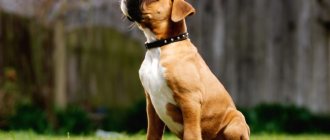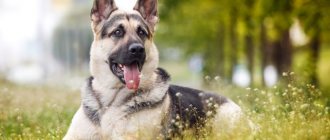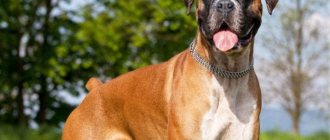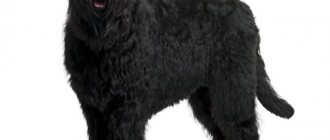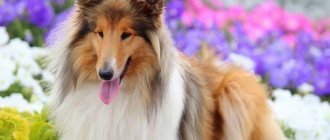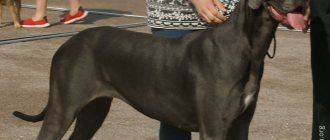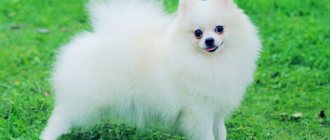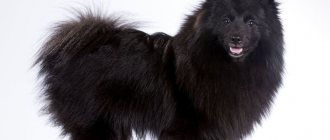If you need not only a loyal friend, but also an excellent protector, then the German Boxer dog breed is what you need. From the photo of the German boxer it is clear that this breed of dog was simply created to protect humans.
In many cases, this type of dog is used for police service and private security. However, despite its muscular body and intimidating appearance, this breed has a kind character. This means that such a dog is capable of becoming a loyal friend and comrade for its owner.
Breed characteristics
| Short description | |
| Origin: | Germany |
| Conditions of detention: | In a house without a garden, in an apartment |
| Purpose: | Companion dog, guard dog, fighting dog |
| Color: | Red and brindle with black mask and white spots |
| Wool length: | Short |
| Adult dog size: | The height of females is 53-59 cm, males 57-63 cm, weight of males is approximately 30-35 kg, females - 25-30 kg. |
| Average life expectancy: | 9-15 years |
| Walk: | A mandatory minimum of 2 times a day is required. |
| Physical activity needs: | Average physical activity needs (walking 1 to 3 hours per day) |
| Fédération Cynologique Internationale (FIC) classification: | Group 2: Pinschers and Schnauzers, Molossians, Mountain and Swiss Cattle Dogs; Section 2: Molossians |
| Puppy price: | From 15,000 to 30,000 rubles |
History of the origin of the species
There are two versions of the appearance of the breed: selection of European dogs and selection of Greek dogs. According to the first theory, the German Boxer is a relative of the Northern European Great Dane, after which the Mastiff was bred. The second hypothesis describes the Boxer as a direct descendant of the Ancient Greek Molossus - a war dog.
One way or another, there is no exact place and time of the birth of the breed. One thing is known - the closest ancestor of this dog is the extinct Brabant Bullenbeiser (“bullenbeisser”). It was popular in the 17th century as a hunting dog. It was used for baiting wild boars, deer, bulls and other large prey. However, after the invention of firearms, he became a guard dog.
At the end of the 19th century in Munich, Georg Alt crossed the Bullenbeiser with the English Bulldog. This was done in order to reduce aggressiveness and improve physical characteristics. Already in 1850, the German Boxer was presented at the Munich Exhibition. A year later, the first breed club appeared, and in 1904 the standard was determined.
External characteristics gave the breed the nickname “two-nosed”. Many individuals had a groove on the bridge of the nose and nose, which divided the cartilage in half. Such representatives were considered purebred.
The first German Boxers were white. But later the standard was changed, because a dog with this color is too noticeable and is not suitable for military service. Nowadays, white wool is very rare and is considered a symbol of good luck.
The dog got its name because of its characteristic feature. When participating in a fight or game, the dog stands on its hind legs and “boxes” with its front legs.
Distinctive features
The German Boxer has a strong, square build: the length of the body is proportional to the height at the withers. This dog is quite compact, but has good physical characteristics and well-developed muscles. The breed standard is constantly changing, the latest changes were made in 2002 (ban on tail and ear docking) and 2008 (still in effect).
The size of the dog is average: height at withers for males – 57-63 cm, for females – 53-59 cm; weight ranges from 25 to 30 kg. The fat layer is minimal, the bulk is muscle .
Only those individuals that perfectly match the description are allowed for further breeding:
- The head should be almost square. The length of the muzzle to the length of the skull is 1:2, the shorter the better. The width should be approximately the same. The skull should be neither round nor elongated; the best shape is angular with a marked furrow on the forehead between the eyes.
- The jaws are strong: the lower one overlaps the upper one ("overbite"). The fangs are widely spaced and should not be visible when the mouth is closed. The lips are jagged. The upper one is much more powerful than the lower one; it covers the free space formed by the fangs. The cheekbones are not pronounced, smoothly transitioning to the muzzle.
- The nose is flat, oval, with wide nostrils. The lobe is slightly turned up. Pigment color is black.
- eyes . Round in shape, not bulging or slanting. Set wide apart. The color of the iris is shades of dark brown. The eyelid pigment is black.
- The ears are set high and hang down to the sides of the head. Size – medium. Until 2002, it was customary to dock to avoid injury in a fight. Now they remain in their original form.
- The body is square and muscular. The back is short, strong and wide. The chest is deep (reaches the middle of the elbow joint) and wide. The ribs are elongated, but not barrel-shaped. The stomach is elegantly tucked. The neck is long, rounded, powerful, and has an arched shape. The tail is set high, well built and not docked.
- Limbs : front straight, parallel with strong bones; the hind ones have developed muscles, slightly longer than the front ones. Pads with dense covering, claws large black.
- The coat is short, shiny, smooth. Color: shades of red, brindle, white are not included in the standard, but markings on the chest are acceptable. Features a black mask on the face and spots on the ears.
When breeding a breed, not only external data are taken into account, but also temperament, movements, gaze, and inherent mood. Any defects are unacceptable.
Interesting color
The coat of Boxer dogs is smooth and iridescent in the sun, short, dense and hard. There are two types of coat color:
- Ginger;
- Brindle.
The red coat color includes shades of light yellow, orange, red and brown. The most popular “golden mean” is a bright red color.
Boxers of another type have a tiger color: on light and red fur there are dark or black stripes along the ribs of the animal.
The stripes are noticeably different from the main color and have clear contours. Small white markings are also normal for the German breed.
Boxers of other colors - white, gray, black - are not actually representatives of the noble German breed.
Photo of an adult dog
Photos of puppies
Features of character and behavior
The former aggressiveness of the Boxers' predecessors was replaced by good nature and a balanced mental state. Despite their rather intimidating appearance, German Boxers are considered excellent family pets and even nannies for children. They make contact easily and can distinguish between friends and enemies. However, even with all the positive qualities, this dog needs training and education.
Advantages
- Definitely a working dog , bred to serve and assist humans. A born hunter and guard, he is devoted to his master and will protect him at the cost of his life. Fearless and selfless. Easily learns thanks to its flexible nature and sharp mind. Trainable.
- Gets along well with people , especially with children. Will become a family friend, a companion on hikes and trips. Boxers are playful and cheerful, love to run and need regular exercise. They are not prone to aggression - they have a fairly strong nervous system.
- The German Boxer is a cunning and funny dog , in which both a stern protector and a child always coexist. He will fool around at home and have fun with his owner, but do not forget that this breed was created for hunting.
- Quite easy to care for and suitable for keeping in an apartment. Experts recommend this breed even to a novice breeder. It is often used as an official one for work in the police, the Ministry of Emergency Situations, and customs control.
Flaws
- German Boxers cannot stand being alone. They need constant attention from their owner and sincere love. They do not tolerate drafts and frosts well due to their short fur.
- Although they are good with others, these dogs may have difficulties with other pets, especially dogs. They are always ready to go into battle. When walking, it is necessary to keep your pet on a leash to avoid fights and attempts by the animal to keep up with the “prey”.
- They can be cunning. Because of this characteristic, it is worth teaching and raising a Boxer from childhood, limiting him to boundaries. They love to beg and manipulate the feelings of the owner. The dog is prone to obesity and has intestinal problems: diarrhea, flatulence.
- The breeder must accept the fact that this breed drools a lot. They are unclean and love to wallow in dirt. In addition, they often snore during sleep.
Owner reviews
Most owners speak of their pets as wonderful companions, very smart and quick-witted. Boxers are highly trainable and listen to their owners. Dogs remain playful until very old age.
Among the most pressing problems that Boxer owners face are a number of diseases specific to this breed, as well as a large amount of drool.
In conclusion, we can say that Boxers are unique dogs that are excellent guard dogs, but at the same time they are distinguished by loyalty and friendliness. But before purchasing a boxer, the potential owner is advised to weigh the pros and cons. This breed of dog is recommended only for energetic people who can devote a lot of effort to training and walking their pet.
Care and maintenance
The German Boxer is not difficult to keep and is perfect for living in an apartment and in a large family. It is required to follow a developed diet, monitor the cleanliness of the coat and mucous membranes, and pay attention to training.
For the pet’s comfort, the owner must choose a place and cover it with a comfortable lounger or blanket (preferably without direct sunlight and drafts), purchase a collar and a strong leash, a metal or ceramic bowl with adjustable height, and quality toys.
For the puppy, a “toilet” is determined in the house and covered with diapers. Since it is impossible to walk with him at an early age, the dog must be accustomed to one place. Later, the pet is regularly walked.
Nutrition
When determining a menu for your pet, it is worth considering that the Boxer is prone to obesity. He should not be overfed and spoiled often. The serving size is calculated using the formula: 20% of the dog’s weight. Puppies are fed 4-5 times a day, adults - 2 times.
For full development, it is necessary to include all useful compounds and elements in the diet. Most of them are found in premium dry food. But more often, breeders are inclined towards natural nutrition, in which case the dog needs the following products:
- Meat (since Boxers are descendants of hunting dogs, their diet should consist of 80% proteins: chicken, turkey, rabbit, raw and boiled beef);
- Vegetables and fruits;
- Cereals and cereals (buckwheat and rice are best);
- Fermented milk products (cottage cheese, kefir);
- Unsalted fish and eggs.
When choosing a natural diet, the owner needs to provide the pet with an additional vitamin complex: suspensions or tablets that contain calcium, mineral salts and other useful compounds.
In order for a dog to develop correctly, it should not be fed human food, especially hot, sweet, spicy, flour and salty foods. Fried foods are also not recommended. As a treat, it is recommended to buy special bait or give your pet chopped cheese.
There is a myth that all dogs need bones. In fact, you need to be careful with this product. Small and sharp bones can seriously injure the digestive system, so you should not feed your pet tubular chicken and fish bones; boiled beef and pork are not recommended. It is allowed to give raw femoral knuckles, which the pet cannot chew, but will perfectly clean its teeth with them.
Health
- German Boxers are not known for their good health. Life expectancy ranges from 9 to 15 years, but the average is no more than 10. This breed has many diseases that are inherited. They often die from cancer (about 40% of cases).
- In addition, they are not resistant to hot and cold climates and require warm bedding and protective clothing. They can get sick due to drafts.
- Breeders are striving to reduce the mortality rate of the breed, but they are still far from an ideal healthy body. Unfortunately, the range of diseases these pets have is extensive. They, like no one else, need timely vaccination.
Vaccinations
Vaccination of a puppy is an important stage that will form the dog’s immunity for its entire life. A pet can contract dangerous diseases (enteritis, leptospirosis) in early childhood before vaccination. Therefore, it is necessary to observe incubation before taking the medicine and 14 days after vaccination. In addition, you need to carry out the deworming procedure (getting rid of worms) two weeks in advance using special preparations.
The dog must be absolutely healthy. Deviations from temperature up or down are not allowed. Vaccination is carried out at veterinary centers by specialists. You cannot perform this procedure yourself.
There are two types of vaccination required:
- Complex (para flu, enteritis, leptospirosis, plague, adenovirosis) is done at the age of 8 weeks, 12 weeks, 6 months, 12 months and annually;
- Rabies vaccinations are given at 6-7 months and repeated every year.
Each pet must have a veterinary passport; it records all vaccinations and medications the dog takes (for worms, fleas and other parasites).
Diseases
- Many Boxer diseases are associated with digestion: volvulus, flatulence, diarrhea, bloating, obesity, allergies. You can avoid them with the help of a balanced diet and a strict diet.
- Individuals also suffer from deformation of the skull and jaw, which leads to breathing problems. Characterized by joint dysplasia and spinal curvature.
- They can be born deaf; white dogs are prone to this. About 20-40% of puppies are born deaf in one or both ears. In addition, German Boxers are prone to eye diseases (entropion).
- Frequent cases of cardiac diseases that progress as the dog ages. Pets often die from cancer.
Walk
- Boxers do not need intensive training and physical activity . They are used to living in small areas and are not suitable for the street. However, like all dogs, German Boxers need to be walked 2-3 times a day for 30-40 minutes . Puppies are walked more often (starting at 6-8 months).
- To avoid overloading the spine and limbs, the puppies are carried down the steps by hand and walked with them for no more than 10-15 minutes, but 5-6 times a day.
- These dogs love to run, but it is not advisable to let them off the leash. They can attack dogs to fight or play, but with their size they can cause harm. In addition, Boxers are prone to tracking cats and small prey and often run away. Dog trainers advise using a harness rather than a collar, this way the dog feels more comfortable.
- The animal must move a lot : jump, run after the ball, go through obstacles. Without proper exercise, this breed loses control. The more energy Boxer expends during a walk, the calmer he will be at home.
Do not allow your pet to pick up dirty objects. He may swallow small parts or get an infection. It is important to give him socialization and communication with animals and people.
Grooming
The German Boxer's coat is thin and short, so these pets do not need constant brushing. It is enough to wipe the dog with a towel once a week or comb it with a soft rubber brush to remove lost hair (especially during the molting period). You need to bathe no more than once a year, but it is recommended to clean the coat once a month with a solution of vinegar, water and alcohol (1:1:1).
The folds on the pet's face and eyes require special attention. They need to be wiped with cotton wool or a scarf 2-3 times a week, ears are washed once a month. It is necessary to brush your pet's teeth with a soft baby brush and special toothpaste. Nails are trimmed every month.
Paw care is an important point in maintenance. Although the skin of the Boxer's pads is quite rough, it is often injured. You need to wash or wipe your limbs after walking and lubricate them with a rich cream.
Nutrition
A balanced and proper diet is the key to good immunity and longevity of your pet.
Not only puppies, but also adult dogs should receive the required amount of proteins, carbohydrates, fats, vitamins and microelements regularly.
Boxer puppies up to two months of age should eat up to six times a day. Then the number of meals is reduced to four times. From six months to nine months of age, the pet is transferred to three meals a day. The boxer is then fed twice a day.
The animal's menu must include the following products:
- meat;
- sea fish;
- porridge;
- fruits;
- vegetables;
- cottage cheese;
- milk;
- kefir or fermented baked milk.
Vegetables and cereals need to be slightly salted during cooking. To make the coat more shiny and beautiful, add 2 teaspoons of olive oil to the Boxer's daily diet.
It is also acceptable to give the animal premium dry food
The German Boxer is prone to obesity and volvulus, so do not overfeed the dog
It is highly not recommended to feed your pet fish and tubular bones, spicy, smoked foods, sweet pastries, baked goods made from white flour, legumes and pork.
Mating
- Dogs become sexually mature at 18-20 months. By this time, the bitch should already be in her third heat. Dogs can be bred for 10-15 days; it is important to select such pets so that their qualities complement each other and are passed on to the offspring in the right form.
- It is important to introduce boxers and walk them together . Not all individuals accept each other. The bitch should be open and flirt with the male. After this, it is customary to take them to the boy’s territory, but if the female is restless, it is important to change the place.
- For the first time, you can invite a specialist who will help both the dog and the owner. He will explain the rules of mating and show how to help your pet.
- Breeders must hold the bitch and help the dog. After entering the “castle,” you cannot let your pets go; it is better to hold on for the next 30-40 minutes. The mating is repeated after a couple of days.
Boxer diseases
Despite their powerful muscular body, endurance and strength, boxers, like other dogs, are susceptible to various diseases.
The most common diseases are:
- Pathologies of the cardiac and vascular systems: aortic valve stenosis and cardiomyopathy;
- Volvulus (tympanitis);
- Oncological diseases;
- Colitis (inflammatory process of the colon);
- Thyroid disease (hypothyroidism);
- Hip dysplasia (hereditary disease);
- Corneal dystrophy (eye disease);
It should be remembered that in order to prevent the disease and begin treatment on time, you need to systematically conduct examinations with a veterinarian. Today there are many modern diagnostics that allow early detection of deviations from the norm and various pathologies.
Key points in training
You need to start training a dog from a very early age, preferably from the first after it appears in the house. It is important to accustom your pet to its name, toilet, feeding and sleeping place. After this, you can start learning the basic commands:
- "Near";
- "Place";
- "It is forbidden";
- "Drop";
- "Sit",
- "Lie";
- "Serve";
- "Voice".
Boxers are incredibly intelligent and quick to learn, but tend to be stubborn. Therefore, as an adult, it is difficult to get him interested in activities. Puppies are often distracted. All training should be carried out in a playful manner, without the use of brute force and with motivation (treats, toys).
German Boxers are prone to dominance, so they need a strict owner who can show his leadership qualities and convince the pet to obey.
Read about how to properly train a dog in the article: “Training a puppy: effective methods from dog handlers, learning commands at home.”
Vaccinations
their first vaccination at 8 weeks of age. Then after 4 weeks a second vaccination is given. This is done in order to create stable specific immunity in the pet.
During repeated vaccination, a complex vaccine is administered that contains the rabies virus.
Immunobiological drugs are then administered upon reaching one year of age and repeated every 12 months.
Vaccination provides your pet with lasting immunity to the following diseases:
- plague;
- rabies;
- parainfluenza;
- hepatitis;
- enteritis;
- leptospirosis.
Important! Two weeks before vaccination, the dog must be treated for worms and parasites.
Timely vaccinations will help to avoid many health problems in Boxers and will contribute to longevity.
How to choose a puppy
Before buying a puppy, you need to find a suitable nursery with good recommendations and personally communicate with the breeder. Find out the living conditions of the dogs and their diet. If possible, look at your parents and find out about their illnesses and weaknesses.
The puppies themselves should be active and curious. External characteristics must meet the standards: shiny coat, clean eyes and ears.
The price of a German Boxer depends on the officiality of the breeder and pedigree. Puppies can be of three classes:
- Pet class (pet without status);
- Breeding class (dogs approved for breeding);
- Show class (pets that are offspring of champions and intended for exhibitions).
So a Pet-class puppy will cost from 10,000 rubles , and for a Show-class dog you will have to pay 30,000 rubles or more. You can buy a Boxer from an unofficial one for 5000-6000 rubles . But this is a certain risk: it is unknown in what conditions the parents grew up, whether they were prone to aggression and diseases.
The German Boxer will definitely make the best pet and will happily curl up on the couch and watch TV with the family. But before buying, you should think about your free time and the opportunity to raise and care for a dog, because this is a big responsibility.
3.7 / 5 ( 3 voices)

